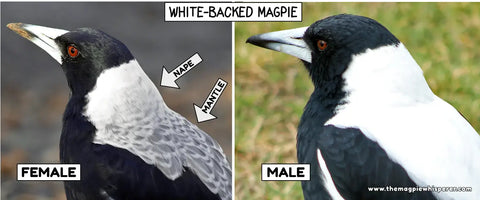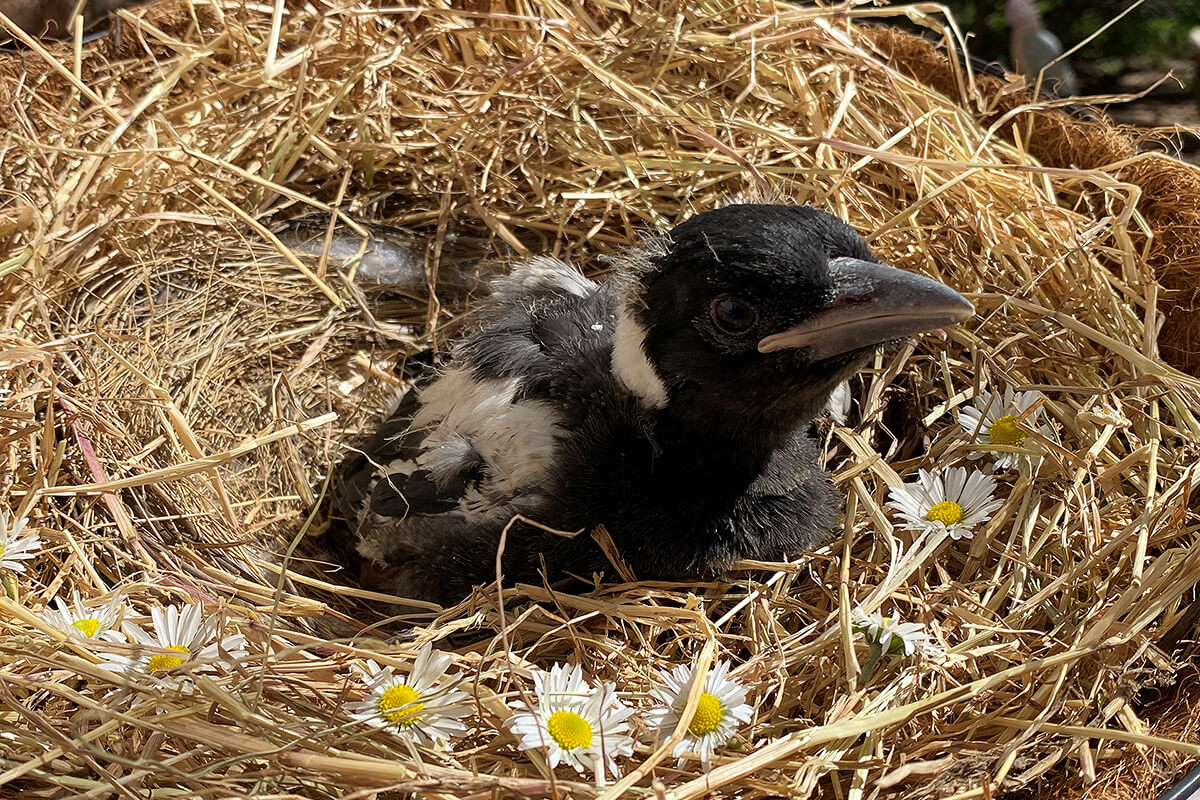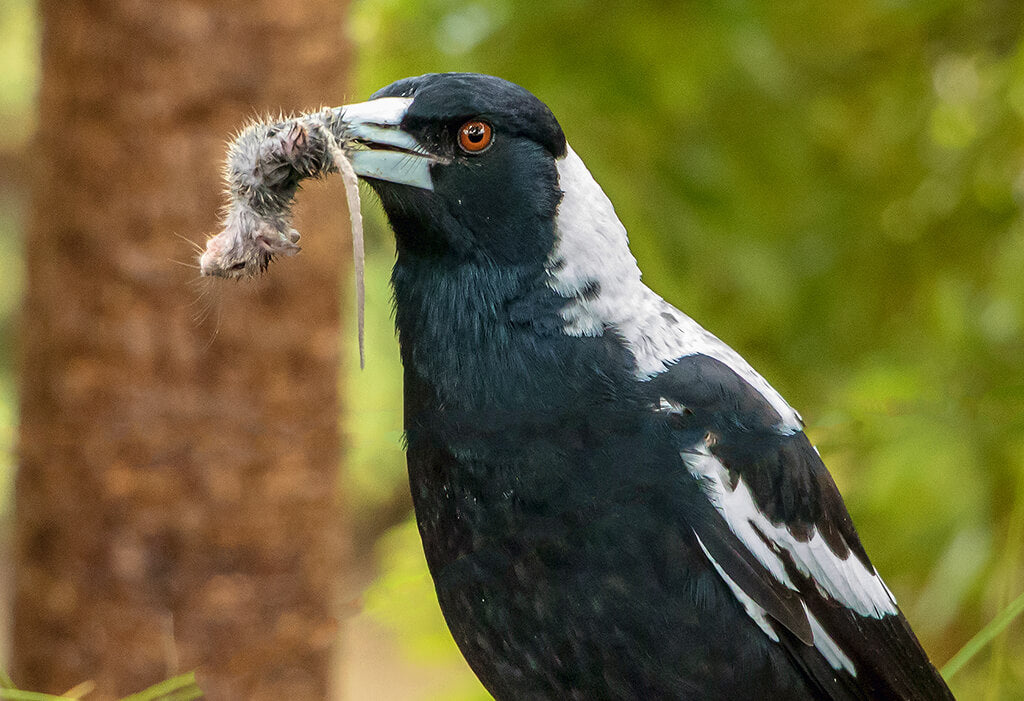Australian Magpie Information - Habitat, Diet, Behaviour, and More
Posted by The Magpie Whisperer on
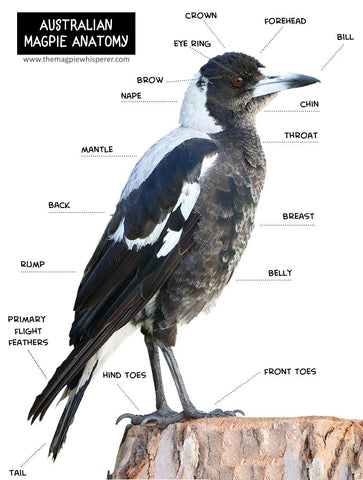 The Australian Magpie (Cracticus tibicen) is a species of bird native to Australia and parts of New Guinea. It's a medium-sized bird, with striking black and white plumage and a long, strong beak. They're part of the Artamidae family, which also includes the butcherbirds, currawongs and woodswallows.
The Australian Magpie (Cracticus tibicen) is a species of bird native to Australia and parts of New Guinea. It's a medium-sized bird, with striking black and white plumage and a long, strong beak. They're part of the Artamidae family, which also includes the butcherbirds, currawongs and woodswallows.Australian Magpies are usually friendly towards humans, but when it's breeding season (from August to October), they can get a bit protective of their nests and may swoop down on people. However, these birds are still greatly loved by many Aussies.
The Melodious Songs of Australian Magpies
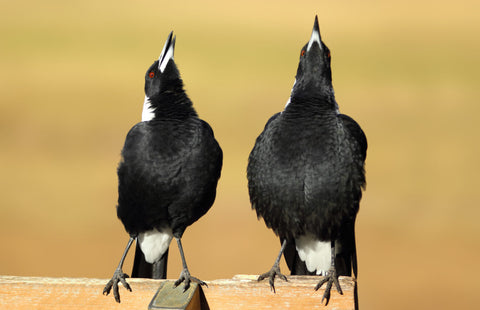
The songs of Australian Magpies are considered to be some of the most beautiful and intricate bird songs in the world. The birds have a varied and complex vocal repertoire, consisting of a wide range of musical notes, trills, and warbles.
Their songs are not just beautiful, but also serve several purposes, such as communicating with other birds, marking their territory, and attracting mates. Australian Magpies are also known for their ability to mimic other birds and even human speech, which has added to their popularity as a beloved bird species in Australia.
Lifespan
In the wild, Australian magpies have an average lifespan of around 25 years. However, they have been known to live up to 30 years under ideal conditions in the wild.
It's worth mentioning that just like humans, the lifespan of an individual Australian magpie can be influenced by various factors. For instance, unfortunate events such as falling prey to predators or accidents like being hit by a car can significantly shorten their lifespan. However, Australian magpies residing in safe habitats with ample food and fewer threats from predators tend to live longer and healthier lives.
How to Determine the Sex of an Adult Australian Magpie
When observing Australian Magpies, subtle differences can be used to determine their sex. For example, males tend to be slightly larger than females and have longer, thicker bills. Additionally, male magpies have a more distinct white patch on their backs, while females have a motley pattern of grey shades and markings on their backs.
Can You Identify the Gender of a Young Magpie?
Identifying the gender of a juvenile magpie based on physical characteristics can be tricky. It's a common misconception that a young magpie with mottled gray feathers on its back is always female. However, this is not necessarily true, as juvenile males can also display these markings. To see the different stages of plumage development in a juvenile magpie, click here.
It is visually impossible to determine their sex at such an early stage. It is only after the bird has developed its adult plumage, which can take up to 2-3 years, that its gender can be accurately determined. To read more about identifying genders in magpies, click here.
Habitat
The Australian Magpie is a bird species that can thrive in a wide range of habitats, including urban areas, parks, gardens, golf courses, farmland, and rural areas. They tend to favor habitats that offer a combination of tall trees for nesting and open areas for foraging. In urban and suburban areas, they often nest in trees along streets or in parks. In rural areas, they may nest in tall trees near farmland or in woodland habitats.
Apart from natural habitats, these birds are known to exploit man-made structures, such as power lines and buildings, for perching and nesting. They often perch on telephone poles or fence posts, and may even construct their nests on man-made structures, such as on the roofs of buildings or in power line towers.
To establish and defend their territories, Australian Magpies are highly territorial and tend to select locations that offer adequate food and nesting sites. They use their songs to communicate with other magpies in their territory, and to defend their territory against other magpies or potential predators.
In summary, Australian Magpies are remarkably adaptable and can thrive in various habitats as long as there are trees and open areas for foraging. This flexibility has enabled them to establish large and stable populations across their range.
Measurements And Weight
- Length: 37-43 cm (14.5-17 in)
- Wingspan: 65-85 cm (25.5-33.5 in)
- Weight: 220-350 g for males, and 164-271 g for females
It's important to mention that there might be some differences in dimensions and weight among the different subspecies of the Australian Magpie.
Feeding Habits of Australian Magpies

Australian Magpies eat both plants and animals, making them omnivores. They are highly skilled foragers and hunt for prey on the ground. They have excellent hearing, which they use to locate their target, and then use their sharp beaks to pierce the ground and retrieve their meal.
The Australian Magpie has a diverse diet, including a range of fruits like seeds, grains, figs, walnuts, and prickly pears. They have even adapted to safely consume the poisonous cane toad by eating only the non-toxic parts. They also feed on a wide range of insects, including earthworms, skinks, millipedes, cockroaches, grasshoppers, crickets, flies, mosquitoes, cicadas, weevils, moths, caterpillars, ants, bees, spiders, spider egg sacs, and even scorpions.
These adaptable birds also eat other animals, such as frogs, skinks, geckos, mice, and carrion. Their diverse diet allows them to thrive in various habitats and environments.
📰 Feeding Magpies the Right Way: How to Keep Your Feathered Friends Happy and Healthy
Nesting and Egg Development
 The nesting behavior of female Australian Magpies is fascinating, as they are the sole nest makers. These birds construct substantial nests in tall trees, usually in the fork of a branch, at a height of 10 to 15 meters above the ground. They use various materials such as twigs, grass, bark, and other plant matter to create their nests. Unfortunately, they sometimes may incorporate bizarre items such as cable ties, coat hangers, plastic bags, fishing line, and other debris in their nest-building.
The nesting behavior of female Australian Magpies is fascinating, as they are the sole nest makers. These birds construct substantial nests in tall trees, usually in the fork of a branch, at a height of 10 to 15 meters above the ground. They use various materials such as twigs, grass, bark, and other plant matter to create their nests. Unfortunately, they sometimes may incorporate bizarre items such as cable ties, coat hangers, plastic bags, fishing line, and other debris in their nest-building.
Egg-Laying
 The female Australian Magpie typically lays a group of eggs called a "clutch" that can have 2 to 5 eggs in it. These eggs have a light blue or greenish-blue color and are spotted with brown or purplish hues.
The female Australian Magpie typically lays a group of eggs called a "clutch" that can have 2 to 5 eggs in it. These eggs have a light blue or greenish-blue color and are spotted with brown or purplish hues.
The number of eggs in a clutch may change depending on various factors. If there is a shortage of food, the female may lay fewer eggs in order to conserve her energy for incubation and caring for the chicks. On the other hand, if there is an abundance of food, the female may lay more eggs. Environmental factors such as weather and temperature can also influence the number of eggs laid in a clutch.
Egg Development, Hatching, and Fledging
Once laid, the eggs take around 20 days to hatch. While the eggs are developing, the female Magpie sits on them to keep them warm. The male Magpie may assist by bringing food to the female while she is incubating. Once the eggs hatch, both parents share the responsibility of feeding and caring for the chicks. The chicks grow rapidly and leave the nest around 4-5 after hatching, but they remain dependent on their parents for several months.
Breeding and Swooping Season

The breeding patterns of magpies are influenced by their geographic location. While some magpies breed between June and December, those living in the Victorian and New South Wales Alps continue breeding until the end of January. However, the breeding season may vary in certain regions due to environmental factors such as climate and weather conditions. For example, a shortage of rainfall or extreme temperatures may impact the timing of the breeding season. Thus, understanding the specific environmental factors that may affect magpie breeding is important when studying these birds.
During the breeding season, magpies exhibit defensive behavior to protect their nests and chicks, and may swoop anyone they perceive as a threat. While this behavior can be intimidating to humans, it's essential to note that magpies are not naturally aggressive animals. They are simply defending their offspring and territory, just like any parent would.
Consider the following scenario: an unknown individual is loitering in your backyard or forcibly invading your residence while a vulnerable infant is in close proximity, necessitating protection by any means necessary. Under such circumstances, one might experience sensations of fear, anxiety, and fury. In the face of such a situation, one's innate instincts would prompt them to safeguard their child. This reflexive behaviour is no different than that exhibited by a magpie parent in defense of its offspring. It's important for most people to understand this fact.
📰 Please consult our comprehensive article on Magpie swooping available here.
Subspecies
 The Australian Magpie is divided into different types known as subspecies. These subspecies are groups of magpies that share many similarities but also have small differences, such as their physical appearance and where they live.
The Australian Magpie is divided into different types known as subspecies. These subspecies are groups of magpies that share many similarities but also have small differences, such as their physical appearance and where they live.
These differences may seem small, but they are enough to distinguish each subspecies from the others. However, this classification of subspecies is not without controversy. There are varying opinions among experts on how to classify them, which leads to ongoing discussions and debates in the scientific community.
Here are some of the known subspecies of the Australian Magpie, each with its unique features and habitat:
The Black-backed Magpie (as seen in the image in the left-hand column)
-
Gymnorhina tibicen tibicen: Found in the eastern and southeastern parts of Australia, including Tasmania. This subspecies has a distinct black and white plumage with a white belly and white wing patches.
- Gymnorhina tibicen terraereginae: Found in the northwestern parts of Australia, including the Kimberley region in Western Australia. This subspecies has a slightly different plumage pattern than the other subspecies, with more extensive white markings on its wings and tail.
- Gymnorhina tibicen eylandtensis: Found on Groote Eylandt, an island off the coast of the Northern Territory. This subspecies has a smaller body size and narrower white wing patches than other subspecies.
The White-backed Magpie (as seen in the image in the right-hand column)
- Gymnorhina tibicen telonocua: Found in the central parts of Australia, including the Northern Territory and South Australia. This subspecies has a slightly different plumage pattern than the other subspecies, with a more extensive white patch on the back of its neck.
-
Gymnorhina tibicen hypoleuca: Found in the western parts of Australia, including Western Australia and the Northern Territory. This subspecies is similar in appearance to the eastern subspecies but has a slightly smaller size and narrower white wing patches.
.
Protecting Australian Magpies: Report Suspicious Activity to AuthoritiesAustralian Magpies are a treasured native species that are protected under the State Wildlife Legislation (Nature Conservation Act 1992). It is essential to know that harming these birds, their nests, eggs, or young is strictly prohibited and illegal. If you witness any suspicious activity that may involve harming magpies or their nests, it is imperative to report it immediately to the appropriate authorities. Reporting such behaviour can help in saving the magpies and their future generations. The RSPCA national hotline at 1300 278 358 or the local wildlife authority in your state or territory are the best resources for reporting such activities. By taking prompt action and reporting any suspicious behavior, we can all contribute to safeguarding these magnificent birds and ensure their continued survival for generations to come. Remember, we are all responsible for protecting our native wildlife, and every small action counts towards conserving their natural habitat. |

